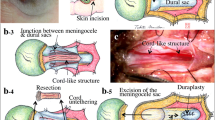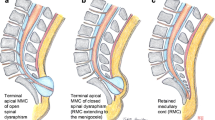Abstract
Background
A retained medullary cord (RMC) is a rare closed spinal dysraphism with a robust elongated neural structure continuous from the conus and extending to the dural cul-de-sac. Four cases of RMC extending down to the base of an associated subcutaneous meningocele at the sacral level have been reported.
Clinical presentation
We report an additional case of RMC, in whom serial MRI examination revealed an enlargement of the meningocele associated with RMC over a 3-month period between 8 and 11 months of age, when he began to stand. At the age of 12 months, untethering of the cord was performed. Histologically, the presence of ependyma-lined central canals in the dense neuroglial cores was noted in all cord-like structures in the intradural and intrameningocele sacs and at the attachment to the meningocele.
Conclusion
It is conceivable that the hydrodynamic pressure with standing position and the check valve phenomenon were involved in meningocele enlargement. We should be mindful of these potential morphological changes.



Similar content being viewed by others
References
Hashiguchi K, Morioka T, Fukui K, Miyagi Y, Mihara F, Yoshiura T, Nagata S, Sasaki T (2005) Usefulness of constructive interference in steady-state magnetic resonance imaging in the presurgical examination for lumbosacral lipoma. J Neurosurg 103:537–543
Hashiguchi K, Morioka T, Yoshida F, Miyagi Y, Mihara F, Yoshiura T, Nagata S, Sasaki T (2007) Feasibility and limitation of constructive interference in steady-state (CISS) MR imaging in neonates with lumbosacral myeloschisis. Neuroradiology 49:579–585
Lellouch-Tubiana A, Zerah M, Catala M, Brousse N, Kahn AP (1999) Congenital intraspinal lipomas: histological analysis of 234 cases and review of the literature. Pediatr Dev Pathol 2:346–352
Morioka T, Hashiguchi K, Yoshida F, Nagata S, Miyagi Y, Mihara F, Sasaki T (2007) Dynamic morphological changes in lumbosacral lipoma during the first months of life revealed by constructive interference in steady-state (CISS) MR imaging. Childs Nerv Syst 23:415–420
Morioka T, Hashiguchi K, Mukae N, Sayama T, Sasaki T (2010) Neurosurgical management of the patients with lumbosacral myeloschisis. Neurol Med Chir (Tokyo) 50(9):870–876
Morioka T, Murakami N, Shimogawa T, Mukae N, Hashiguchi K, Suzuki SO, Iihara K (2017) Neurosurgical management and pathology of lumbosacral lipomas with tethered cord. Neuropathology 37:385–392
Morioka T, Suzuki SO, Murakami N, Shimogawa T, Mukae N, Inoha S, Sasaguri T, Iihara K (2018) Neurosurgical pathology of the limited dorsal myeloschisis. Childs Nerv Syst 34:293–303
Morota N, Ihara S, Ogiwara H (2017) New classification of spinal lipomas based on embryonic stage. J Neurosurg Pediatr 19:428–439
Murakami N, Morioka T, Hashiguchi K, Yoshiura T, Hiwatashi A, Suzuki SO, Nakamizo A, Amano T, Hata N, Sasaki T (2013) Usefulness of three-dimensional T1-weighted spoiled gradient-recalled echo and three-dimensional heavily T2-weighted images in preoperative evaluation of spinal dysraphism. Childs Nerv Syst 29:1905–1914
Murakami N, Morioka T, Shimogawa T, Hashiguchi K, Mukae N, Uchihashi K, Suzuki SO, Iihara K (2018) Retained medullary cord extending to a sacral subcutaneous meningocele. Childs Nerv Syst 34:527–533
Pang D, Zovickian J, Moes GS (2011) Retained medullary cord in humans: late arrest of secondary neurulation. Neurosurgery 68:1500–1519
Sala F, Barone G, Tramontano V, Gallo P, Ghimenton C (2014) Retained medullary cord confirmed by intraoperative neurophysiological mapping. Childs Nerv Syst 30:1287–1291
Walsh JW, Markesbery WR (1980) Histological features of congenital lipomas of the lower spinal canal. J Neurosurg 52:564–569
Funding
This work was partly supported by the Research Foundation of Fukuoka Children’s Hospital.
Author information
Authors and Affiliations
Corresponding author
Ethics declarations
Conflict of interest
The authors declare that they have no conflicts of interest.
Rights and permissions
About this article
Cite this article
Shirozu, N., Morioka, T., Inoha, S. et al. Enlargement of sacral subcutaneous meningocele associated with retained medullary cord. Childs Nerv Syst 34, 1785–1790 (2018). https://doi.org/10.1007/s00381-018-3812-z
Received:
Accepted:
Published:
Issue Date:
DOI: https://doi.org/10.1007/s00381-018-3812-z




